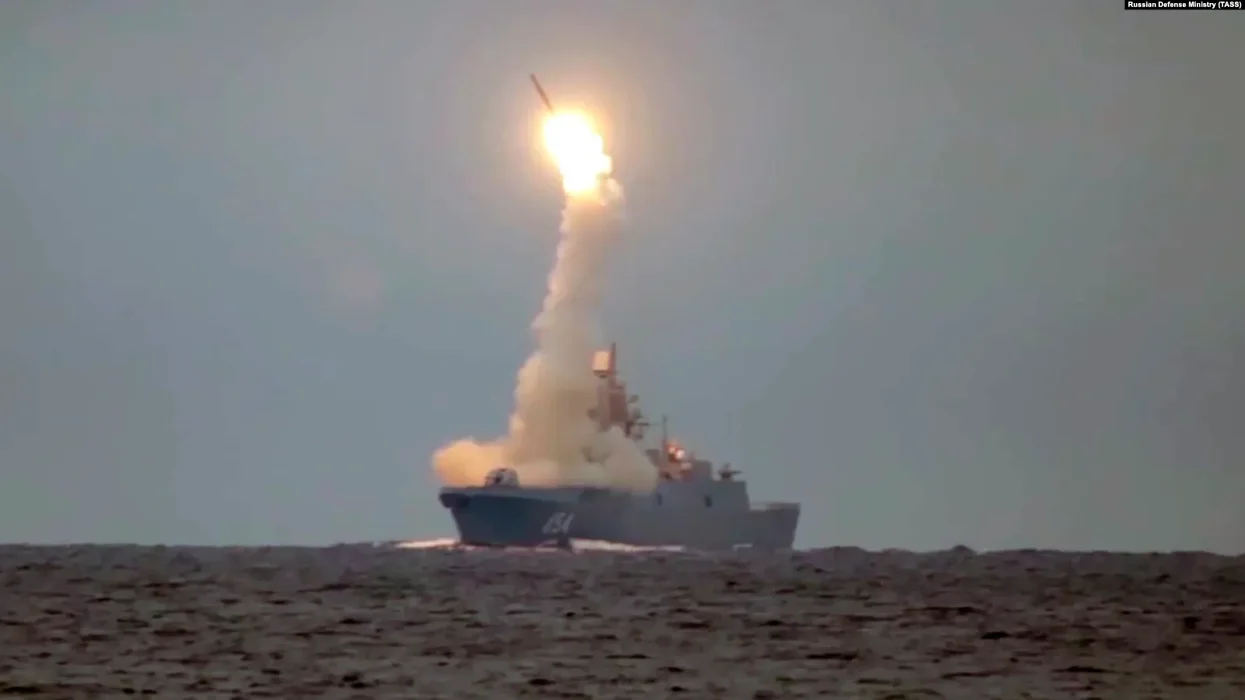En la carrera por el despliegue operacional de Armas Hipersónicas entre las grandes potencias, Rusia ha anunciado el despliegue de su Misil Hipersónico Antibuque Zirkon, con la misión de participar en misiones defensivas en el marco de su denominada “operación militar especial”. El Zirkon es operado desde la fragata misilística “Admiral Gorishov”, una familia de modernos buques en servicio en la flota Rusa desde 2018, con capacidad de operar diferentes misiles balísticos de corto alcance, de crucero y ahora también Hipersónicos. El Zirkon puede desarrollar velocidades superiores a MACH 6, con un alcance de hasta 1.000 km y según ha expresado el Pte Putin, “no existe sistema defensivo en ninguna flota del mundo que sea capaz de neutralizar este tipo de armas”. Por su parte, Rusia afirma haber empleado anteriormente en Ucrania, armas hipersónicas como el misil de lanzamiento aéreo Kinzhal (Dagger).
Vladimir Putin has ordered a frigate carrying the country’s new Zircon hypersonic missiles to begin a cross-ocean cruise in what is the Russian President’s latest muscle flex as tensions with the West escalate over the war in Ukraine.
In announcing the activation of the missiles (it is not clear how many exist), Putin boasted that “It has no analogues in any country in the world,” according to TASS. But what exactly is the Zircon missile, and why is Russia deploying it now? What are the implications of its potential use?
What is the Admiral Gorshkov and where is it going?
The Admiral Gorshkov (full name: “Admiral of the Fleet of the Soviet Union Gorshkov”) is the first ship in a new series of Russian frigates designed to replace old Soviet-era destroyers.
Armed with a host of missile-types, the ship is 130-meters long and is staffed by around 200 crew members. The ship joined the Russian navy in 2018 and forms one of its key strike components.
The ship set off from an unnamed northern Russian port on a voyage across the Atlantic and Indian oceans as well as the Mediterranean, according to Russian Defense Minister Sergei Shoigu, who took part in Wednesday’s ceremony alongside the president.
The current mission is the ship’s first deployment in a potential combat situation, though Russian officials have stressed that the ship’s aim is not attack but defense.
“The main efforts during the campaign will be focused on countering Russia’s threats, maintaining regional peace, and stability together with friendly countries,” Shoigu said in the TASS report.
What are Zircon Hypersonic Missiles?
Zircon (officially: 3M22 Zircon) is an anti-ship hypersonic cruise missile that can reach speeds of over 9,500 kilometers per hour (6,000 miles per hour), around nine times faster than the speed of sound. It can accurately pinpoint targets at a range of more than 1,000 kilometers (620 miles).
Its testing began aboard the Admiral Gorshkov in July 2021 and is now carried on board.
Russia sees the weapons as a way to pierce the increasingly sophisticated U.S. missile defense systems. “This ship, armed with ‘Zircons’, is capable of delivering pinpoint and powerful strikes against the enemy at sea and on land,” Shoigu said.
The Zircon could easily break through the air-defense Patriot missile system that the U.S. pledged to Ukraine during President Volodymyr Zelensky’s December visit to Washington.
Are there other Hypersonic Missiles being developed?
Putin also claimed this weapon had “no analogues in any country in the world” and would “reliably protect Russia from potential external threats.”
In October 2021, Putin announced that Russia had overtaken the U.S. in the hypersonic weapons race, one which began when the U.S. began working on its own Conventional Prompt Global Strike capability which aimed to hit an enemy target anywhere in the world within one hour.
Along with the Avangard hypersonic glide vehicle, which entered combat duty in 2019, the Zircon will play a central role in Russia’s hypersonic arsenal.
TASS reported that the Gorshkov is also armed with Kalibr-NK cruise missiles, weapons which have a range of up to 2,500 kilometers (1,553 miles).
Russia has previously used hypersonic Kinzhal (Dagger) missiles in Ukraine which were used in the early months of the war to destroy an underground missile warehouse and aviation ammunition base in the western part of Ukraine.
How can Zircons be used in Ukraine?
Using the Zircon missiles aboard the Admiral Gorshkov against targets inside Ukraine comes with logistical challenges.
The optimal firing range for the weapons would be from the Black Sea, situated to the south of Ukraine.
To get there, however, the Russian warship would need to pass through the Turkish-controlled Bosphorus Strait. Ankara has said repeatedly since the early stages of the war that it would not permit such access for foreign naval vessels.
While the Admiral Gorshkov could fire on Ukraine from the northern reaches of the Mediterranean, to reach Ukraine it would pass over NATO countries, something that would certainly be considered a major escalation of Russian aggression.
Why is Putin deploying Zircons now?
It certainly seems curious that Putin has deployed the ship and the missilesonly now: he had them both in his arsenal before his full-scale invasion of Ukraine.
But the deployment of the Admiral Gorshkov served as a reason for Putin to celebrate live on state TV despite recent large Russian losses in Ukraine.
Analyst Carl Schuster told CNN that the ship’s deployment makes a political statement for Putin as much as a military one. “He’s trying to show Russia remains a global player despite the costs and international condemnation of his assault on Ukraine,” Schuster said.
Whether the Zircon missile will in fact be used in the dispute over Ukraine is unknown. But either way, Putin’s move sends a clear and pointed signal to the West: Russia is not backing down.
Fuente: https://worldcrunch.com


